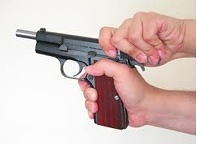 There is no shortage of techniques for clearing a stoppage or malfunction; just trying to explain the difference between the two sets off a never ending debate. Unfortunately, those who have time to engage in never ending debates lose track of what is important. You’re fighting for your life. Whatever works is what is important.
There is no shortage of techniques for clearing a stoppage or malfunction; just trying to explain the difference between the two sets off a never ending debate. Unfortunately, those who have time to engage in never ending debates lose track of what is important. You’re fighting for your life. Whatever works is what is important.
Stoppages usually occur in the cycle of operation of the semiautomatic pistol or rifle, usually caused by a dirty, un-lubricated weapon, bad magazines (covered in a previous article) under powered ammunition, poor grip (including unlocking the wrist while shooting). There are other contributing factors, but these are the primary ones.
A malfunction relates to a mechanically broken weapon that usually cannot be fixed on short notice. I would like to deal with the stoppage techniques in this article.
First, prevention or at least steps we can take to prevent this from happening are important, but please keep in mind there are no guarantees. It is hard to believe that in 2010 the primary cause of stoppages is still dirty, un-lubricated firearms. With all the training and preaching about the importance of cleaning and maintaining our weapons systems many of our fellow officers continue to not take this seriously. A properly maintained and lubricated firearm following the manufacturer’s guidelines is as important to you and those that rely on you as understanding sound tactics and techniques to survive a firefight on the street.
Every time a firearm is taken apart, cleaned, lubricated, and put back together, you should perform a function check. Often at the beginning of a training class I will have the students unload, make the weapon safe and perform a function check. I am often surprised by the number of officers that have been “trained” and carrying the firearm for some time that still do not know how to properly perform a function check on their side arm or a shoulder mounted weapon they may be using. While specific firearms require specific manipulation for a weapon-specific function check, general guidelines for a function check will be covered in a later article.
Inspection of duty ammo as we load our magazines is as equally important. The primary objective is to keep our weapons at peak operational readiness so when we draw the firearm we are confident it will go BANG! (Preventative maintenance guide coming soon.)
So, let’s move on to some more terms such as slide forward, slide to the rear, primary stoppage, secondary stoppage, etc. Slide (or bolt on a semi-automatic rifle or shotgun) forward means that the slide or bolt is all the way forward in the normal locked (firing) position but the weapon did not go BANG! Slide (or bolt) to the rear means that the slide is locked to the rearward position. Primary stoppage means that when you pressed the trigger you heard or felt a hammer / striker fall. Secondary stoppage means that when you pressed he trigger you did not hear or feel a hammer / striker fall.
First, if you have to press the trigger and the weapon doesn’t go “BANG!”, your first immediate action is to MOVE!, preferably toward cover, but if none is available, remember that a moving target is harder to hit than a stationary one.
Reload:
If the indicators are:
(1) Slide or bolt locked to the rear, AND
(2) no hammer or striker fall, chances are that the weapon is empty and needs to be reloaded.
The fix is to reload the weapon and get back into the fight! Sounds simple enough, but how many times have you seen in training shooters; (a) catch an empty magazine, (b) place an empty magazine in a pocket, etc.? If you need to continue shooting, the most important thing is to get the fresh magazine into the weapon and chamber a round. The empty magazine is worthless!
Also, some shooters practice the method of pointing the muzzle of the semiautomatic pistol straight up and flipping it in their hand so the magazine well points out at a ninety degree angle. The theory is that you can see the opening of the magazine well out of your peripheral vision or “combat window” and are less likely to fumble a reload. I can’t say that I’m a big fan of this technique, as pointing the muzzle straight up on a semiautomatic pistol with the slide locked to the rear tells the whole world (including, possibly, your assailant(s)) that YOU’RE EMPTY. I’ve also seen shooters that get the steps wrong and flip the pistol to the ninety degree angle before pressing the magazine release, and then wonder why the magazine doesn’t fall out. (Sir Isaac Newton figured this out a few centuries ago.) I prefer to keep the muzzle pointed at the threat / threat area with the magazine well pointed down while executing the reload.
Primary Method of Stoppage Clearing:
If the indicators are:
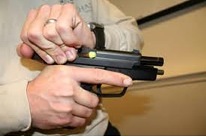 (1) Slide or bolt forward, AND
(1) Slide or bolt forward, AND
(2) hammer or striker fall, your primary method of immediate action is to:
(a) TAP and TUG on the magazine to make sure it is seated;
(b) RACK the slide or bolt,
(c) READY.
All of this should happen as you are moving and the weapon is still up, pointed toward to threat or threat area. With a semi-automatic pistol, a good “par time” for a tap, rack, ready is about 1.0 – 1.5 seconds. With a semiautomatic rifle, about 1.5 seconds. Dipping the muzzle toward the ground and staring at the weapon does nothing except alert your assailant(s) that you are out of the fight.
Secondary Method of Stoppage Clearing:
If the indicators are:
(1) Slide or bolt locked to the rear, AND
(2) no hammer or striker fall, AND
(3) When you press the magazine release, the magazine does not fall out of the weapon, you may have a failure to extract combined with a failure to feed, also known as a “double feed”. We refer to it as a “secondary stoppage”.
The traditional steps to correct this have been:
(a) LOCK the slide / bolt to the rear,
(b) RIP the magazine out,
(c) RACK the slide / bolt to clear the chamber, then
(d) TAP a new magazine into place,
(e) RACK the slide / bolt and
(f) READY.
That’s a lot of moving parts to memorize, and under low stress on the range we’ve seen a lot of shooters get the steps out of order, making the stoppage even worse.
We’ve simplified this “secondary method” into three steps that are more easily remembered under stress:
(a) UNLOAD the weapon, which usually means removing the
magazine, sometimes forcefully;
(b) CLEAR THE CHAMBER (I prefer a physical check with a fingertip
as opposed to a visual check, which assumes that you will have
sufficient light to see the chamber);
(c) RELOAD the weapon, preferably with a fresh magazine, as a faulty
magazine may have caused the stoppage in the first place.
To recap, the best way to minimize the need for stoppage clearing is to:
(a) Have your weapons clean and properly lubricated;
(b) Function test all of your magazines;
(c) Make certain that all of the cartridges in the magazines are
defect-free.
That being said, practice your stoppage drills. You can do them in any safe area that allows movement and has simulated cover. Make certain to remove all live rounds from the area and use only inert training cartridges.
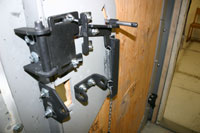 Action Target has developed a revolutionary Tactical Breaching Door™ that affords instructional staff the best option for consistent and realistic training. Our Breach Door adds a whole new dimension to training realism and eliminates the problems faced when training breaching techniques to students. The Tactical Breach Door uses advanced engineering which allows trainers to adjust the tension holding the door closed (shown below) and gives them complete control over the level of force required for a dynamic entry.
Action Target has developed a revolutionary Tactical Breaching Door™ that affords instructional staff the best option for consistent and realistic training. Our Breach Door adds a whole new dimension to training realism and eliminates the problems faced when training breaching techniques to students. The Tactical Breach Door uses advanced engineering which allows trainers to adjust the tension holding the door closed (shown below) and gives them complete control over the level of force required for a dynamic entry. The Tactical Breach Door is designed especially for use in Action Target’s Modular Armored Tactical Combat House (MATCH) shoothouse but it can also be used in a stand-alone frame or can be modified to fit into any existing shoothouse.
The Tactical Breach Door is designed especially for use in Action Target’s Modular Armored Tactical Combat House (MATCH) shoothouse but it can also be used in a stand-alone frame or can be modified to fit into any existing shoothouse.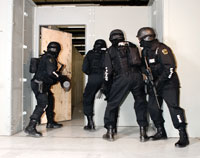 “Action Target’s Tactical Breach Door will advance training to a whole new level. For those of us who train, this innovation is a powerful and functional tool that will allow us to better prepare our teams to protect their own lives and the lives of those around them. Every law enforcement officer, special ops team and military recruit needs to be trained with this door so they can learn the techniques that will make building and room entries safer when breaching the fatal funnel.”
“Action Target’s Tactical Breach Door will advance training to a whole new level. For those of us who train, this innovation is a powerful and functional tool that will allow us to better prepare our teams to protect their own lives and the lives of those around them. Every law enforcement officer, special ops team and military recruit needs to be trained with this door so they can learn the techniques that will make building and room entries safer when breaching the fatal funnel.”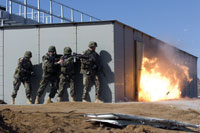 Take a look and you will see that our Tactical Breach Door will meet your training needs and can be used by itself with our free-standing option or integrate it into your MATCH or FlexTact® shoothouse.
Take a look and you will see that our Tactical Breach Door will meet your training needs and can be used by itself with our free-standing option or integrate it into your MATCH or FlexTact® shoothouse.






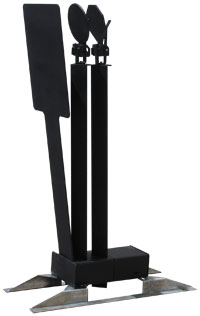 As we learn more and more about the human dynamics involved in armed confrontations, we understand that physical skills that require conscious thought or intellectual processing tend to break down rapidly under high levels of stress. If defensive skills and responses are not programmed in at a subconscious level, the sudden stress may cause us to fumble, freeze or panic. It is in this environment that reactive shooting skills are needed. Such reflexive shooting skills can be taught through the use of extremely short time limits, thus pushing the shooter to function at the limits of reaction and response time. This can be compared to learning how to hit a fast moving ball with a bat or racket, or developing the reflexes to block a punch or kick at full speed. Reactive steel targets provide the instant feedback required to program an officer’s reflexive shooting skills effectively and efficiently.
As we learn more and more about the human dynamics involved in armed confrontations, we understand that physical skills that require conscious thought or intellectual processing tend to break down rapidly under high levels of stress. If defensive skills and responses are not programmed in at a subconscious level, the sudden stress may cause us to fumble, freeze or panic. It is in this environment that reactive shooting skills are needed. Such reflexive shooting skills can be taught through the use of extremely short time limits, thus pushing the shooter to function at the limits of reaction and response time. This can be compared to learning how to hit a fast moving ball with a bat or racket, or developing the reflexes to block a punch or kick at full speed. Reactive steel targets provide the instant feedback required to program an officer’s reflexive shooting skills effectively and efficiently.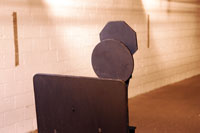 The basic function of the Bobber X-treme™ will probably sound familiar. A steel plate is presented to the shooter from behind cover. This plate can be hit at any time while it is exposed, and a computer interface is used to control the frequency and duration of the target exposures.
The basic function of the Bobber X-treme™ will probably sound familiar. A steel plate is presented to the shooter from behind cover. This plate can be hit at any time while it is exposed, and a computer interface is used to control the frequency and duration of the target exposures.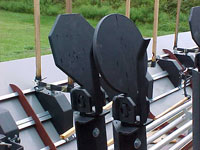 Judgment – Split-second judgment and threat analysis may be the most important elements of the training triangle. The revolutionary Bobber X-treme™ addresses this issue by presenting the shooter with two separate target plates, one directly behind the other. One plate is an 8-inch circle, and the other is an 8-inch octagon. Depending on your training scenario, you can classify all the circle plates as hostile, and all the octagon plates as friendly. When one of the plates jumps up from behind cover, the shooter must quickly determine whether the plate is hostile or friendly and then take the appropriate action. The circles and octagons look enough alike to force the shooter to be sure.
Judgment – Split-second judgment and threat analysis may be the most important elements of the training triangle. The revolutionary Bobber X-treme™ addresses this issue by presenting the shooter with two separate target plates, one directly behind the other. One plate is an 8-inch circle, and the other is an 8-inch octagon. Depending on your training scenario, you can classify all the circle plates as hostile, and all the octagon plates as friendly. When one of the plates jumps up from behind cover, the shooter must quickly determine whether the plate is hostile or friendly and then take the appropriate action. The circles and octagons look enough alike to force the shooter to be sure.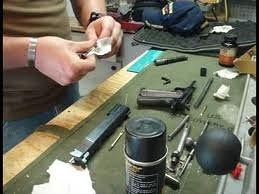
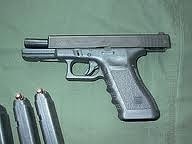
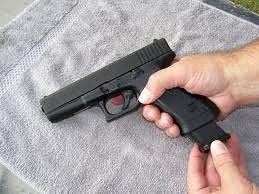
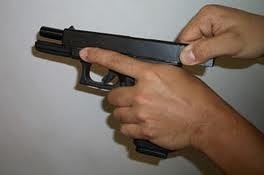
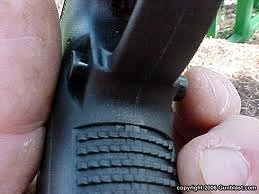
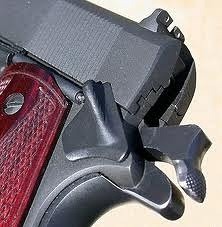
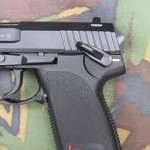

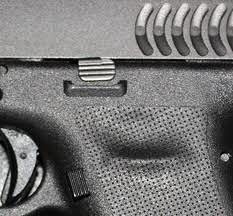 all normally.
all normally.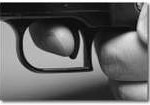
 There is no shortage of techniques for clearing a stoppage or malfunction; just trying to explain the difference between the two sets off a never ending debate. Unfortunately, those who have time to engage in never ending debates lose track of what is important.
There is no shortage of techniques for clearing a stoppage or malfunction; just trying to explain the difference between the two sets off a never ending debate. Unfortunately, those who have time to engage in never ending debates lose track of what is important.  (1) Slide or bolt forward, AND
(1) Slide or bolt forward, AND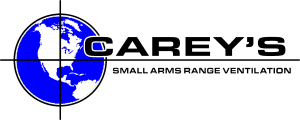 Action Target believes only the best of everything should be associated with all we do. One example of our continuous search for the best is our partnership with Carey’s Heating and Air Conditioning, Inc. After extensive review, we have aligned ourselves with Carey’s to use their heating, air conditioning and ventilation systems in order to provide our indoor range customers with the safest air conditions in the world. Action Target feels it is important for our readers to know more about Carey’s and the integral role they play in the industry. They are not only another provider of air flow products, Carey’s has been an innovator and pioneer with their systems. This article provided by Carey’s below is a little insight into the company. After reading, it will be clear to see why Action Target recommends their systems for our indoor projects.
Action Target believes only the best of everything should be associated with all we do. One example of our continuous search for the best is our partnership with Carey’s Heating and Air Conditioning, Inc. After extensive review, we have aligned ourselves with Carey’s to use their heating, air conditioning and ventilation systems in order to provide our indoor range customers with the safest air conditions in the world. Action Target feels it is important for our readers to know more about Carey’s and the integral role they play in the industry. They are not only another provider of air flow products, Carey’s has been an innovator and pioneer with their systems. This article provided by Carey’s below is a little insight into the company. After reading, it will be clear to see why Action Target recommends their systems for our indoor projects.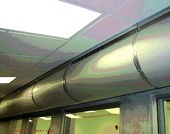 Specifically, the radial air diffusers and plenums are custom built and have been tested to provide laminar air flow at the firing line after proper commissioning. “Laminar” flow is a steady, even airflow required to safely clear contaminate from the respiratory zone of the users of the range. These special diffusers are not available from a standard diffuser supplier. The control system and programming uses standard parts from Johnson Control, but the programming of the equipment is critical. The programming is done by an experienced programmer who has worked on all of the ranges that Carey’s has completed. It is also critical to have the control system installed and tested to automatically shut down if unsafe conditions are detected. This will protect both the occupants of the range and the adjoining areas.
Specifically, the radial air diffusers and plenums are custom built and have been tested to provide laminar air flow at the firing line after proper commissioning. “Laminar” flow is a steady, even airflow required to safely clear contaminate from the respiratory zone of the users of the range. These special diffusers are not available from a standard diffuser supplier. The control system and programming uses standard parts from Johnson Control, but the programming of the equipment is critical. The programming is done by an experienced programmer who has worked on all of the ranges that Carey’s has completed. It is also critical to have the control system installed and tested to automatically shut down if unsafe conditions are detected. This will protect both the occupants of the range and the adjoining areas.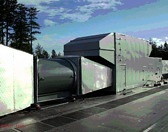 Carey’s Heating and Air Conditioning, Inc. has been an innovative force in range ventilation design for over 15 years.
Carey’s Heating and Air Conditioning, Inc. has been an innovative force in range ventilation design for over 15 years.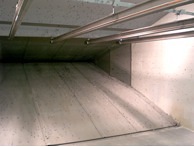 First up is the renovation of Dearborn Police Departments (DPD) firing range. Located in the basement of Michigan’s DPD, this project took careful planning and execution. With the help of several dedicated companies, Action Target managed the removal of DPD’s existing bullet trap, modified the existing target systems, cleaned the range and installed two 16′
First up is the renovation of Dearborn Police Departments (DPD) firing range. Located in the basement of Michigan’s DPD, this project took careful planning and execution. With the help of several dedicated companies, Action Target managed the removal of DPD’s existing bullet trap, modified the existing target systems, cleaned the range and installed two 16′ 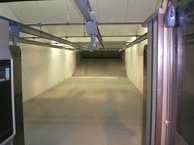 Congratulations to Dearborn Police Department and all those involved!
Congratulations to Dearborn Police Department and all those involved!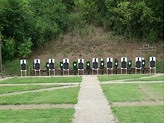 A special thanks goes to Officers Bob Allen and Greg Lee, City and State Officials, Metro Nashville Procurement, Action Target Great Lakes Territory Manager – Jason Snell, Action Target Project Manager – Brian Sanders, and many others for their hard work and a job well done!
A special thanks goes to Officers Bob Allen and Greg Lee, City and State Officials, Metro Nashville Procurement, Action Target Great Lakes Territory Manager – Jason Snell, Action Target Project Manager – Brian Sanders, and many others for their hard work and a job well done!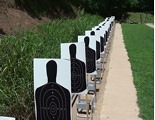
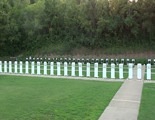
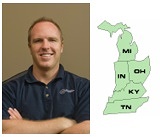 801-377-8033 ext. 158
801-377-8033 ext. 158 Did you know that we are an international company? For years we have been increasing our presence abroad. Countries around the world have been increasing their police and military forces to parallel their growing populations. With more officers and law enforcement staff, countries are turning to Action Target to provide the very best training solutions. With our diverse line of range-related products, we have been fortunate enough to be selected to build some of the largest shooting facilities in the world. We have designed, manufactured and installed indoor, outdoor and M.A.T.C.H. (Modular Armored Tactical Combat House) ranges for our international friends and US military bases located on foreign soil.
Did you know that we are an international company? For years we have been increasing our presence abroad. Countries around the world have been increasing their police and military forces to parallel their growing populations. With more officers and law enforcement staff, countries are turning to Action Target to provide the very best training solutions. With our diverse line of range-related products, we have been fortunate enough to be selected to build some of the largest shooting facilities in the world. We have designed, manufactured and installed indoor, outdoor and M.A.T.C.H. (Modular Armored Tactical Combat House) ranges for our international friends and US military bases located on foreign soil.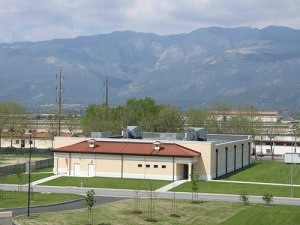 Along with our range and steel target technology, we have been sought for practical application training solutions as well. Action Target has been able to supply some of the best military and law enforcement trainers from the US to provide a comprehensive training program using our range equipment. Our ability to provide training on the equipment we manufacture and install continues to set us apart. We can provide this service with the purchase of our systems for a limited or extended time. If you do not have a range and/or would like to discuss having some specific coursework delivered to your personnel, we would like to discuss the options available with you. We have the capacity to deliver the entire spectrum of shooting-related coursework. Our capabilities including classroom and nomenclature discussions to static live fire, non-live-fire, force on force, close quarter combat, tactical live fire all the way to the pinnacle of tactical combat house live-fire training. Basically, if you have a firearm-related training need, whether it is for equipment, instruction or both, Action Target has a solution. If you would like to know more, please contact the Action Target representative for your area. Their information is below.
Along with our range and steel target technology, we have been sought for practical application training solutions as well. Action Target has been able to supply some of the best military and law enforcement trainers from the US to provide a comprehensive training program using our range equipment. Our ability to provide training on the equipment we manufacture and install continues to set us apart. We can provide this service with the purchase of our systems for a limited or extended time. If you do not have a range and/or would like to discuss having some specific coursework delivered to your personnel, we would like to discuss the options available with you. We have the capacity to deliver the entire spectrum of shooting-related coursework. Our capabilities including classroom and nomenclature discussions to static live fire, non-live-fire, force on force, close quarter combat, tactical live fire all the way to the pinnacle of tactical combat house live-fire training. Basically, if you have a firearm-related training need, whether it is for equipment, instruction or both, Action Target has a solution. If you would like to know more, please contact the Action Target representative for your area. Their information is below.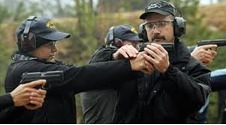 Emphasis:
Emphasis: